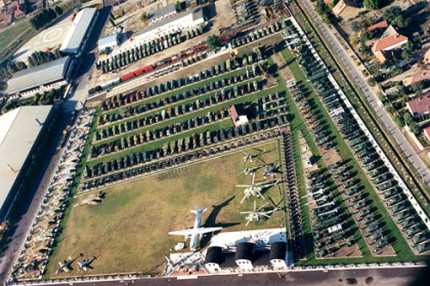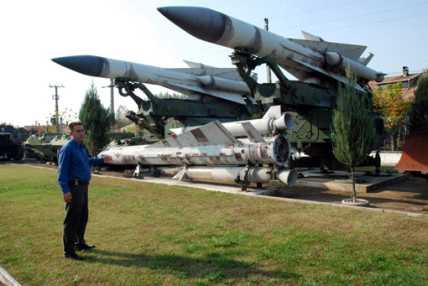Grasshopper, Stalin-Organ, And A Storage Container For Intercontinental Rockets
Szöveg: László Szűcs | 2008. október 30. 7:32Until now, I have only heard about it: those who have been to the largest military collection in Central Europe reckoned it an exhibition of incomparable size and standard. It was high time for me to take a look at it – so I got in my car and headed for the Great Plain…
I’m arriving earlier than what we have agreed in advance, and my guide, a museologist of MoD Institute and Museum of Military Science (HM HIM) is still on his way to the site. The parking spaces in front of the long fence of the Kecel Park of Military Technology are empty now. "Usually there are a few visitors on weekdays, but at the weekends it often happens that there are not enough parking spaces" – says one of the security guards while I’m waiting. I have the time to engage in a conversation and also to look around…
Next to the entrance there is a huge statue. There is no sign of the artist or the title, so I can only assume that the structure commemorates the liberating WWII Soviet Red Army. There are two giant rockets adjacent to the ‘metal heroes’ – as I’m told later, the practice versions of SZ-200 air defence rockets called Vega -, ‘guarding’ the memorial of the liberators.
Of course, this is not the only curiosity here. On the other side of the fence, an enormous rocket-shaped, at least 30 m long and almost 3 m wide deep green metal box draws the attention of the visitor. The late autumn sunshine and the warm weather make the metal plate crackle spookily, but it seems that it is only me who is disturbed by it for the sparrow family hiding between the ribs of the fittings could not care less about it. They got used to the noise. To be honest, I have no idea what this behemoth could be.

"The storage container for an intercontinental rocket, which was donated to the military park by the Ukrainian armed forces a few years ago" – tells me my guide, Captain Attila Süli, who has arrived in the meantime. Officially, the young officer is the collection manager of the military technology park. And the question why he is not staying permanently in Kecel is answered by the strange double status of the park. But in order to understand this, we have to go back in time. Although not much, only twelve years.
The idea of establishing a Park of Military Technology came up in 1996, the year when the military collection in Ladányi Street, Budapest, had to be relocated by the operator, namely the Institute and Museum of Military Science, for the plot of land came into the possession of the local government. Deciding where to relocate the collection mainly consisting of First and Second World War, and Hungarian People’s Army-era military equipments was a serious dilemma. That was when an entrepreneur, Mr József Pintér contacted the leaders of the Ministry of Defence, and offered to create a park for military technologies at his own plant. He has also undertaken to fully maintain the facility.
The offer was accepted, but the technical devices on display are not owned by the entrepreneur, they are still the property of HM HIM, and the park has begun to operate as the affiliate, that is the external exhibition space of the Institute and Museum of Military Science. Therefore a collection manager was needed as well, whose task was mostly to check the presence of the equipment on display, that is why he is not staying in Kecel on a permanent basis. The cooperation agreement between the Ministry and the entrepreneur was signed in January, 1997, and in a short while the relocation of the former Ladányi St. collection has begun. As the locals say: there has never been such a large scale military ’troop movement’ in this town before, and there hasn’t been a similar event to this very day. Huge military lorries thundered along the street of the small town, one trailer after the other. In spite of that, transportation took nearly a year.
Attila Süli tells me: as of 2000, new technical devices have been added to the military park for a part of the redundant combat and regular vehicles of the corps and barracks which were closed down in that period were also transported to Kecel. The technical devices regularly used by the recent and by today’s Hungarian Defence Forces were added to the collection as well. Currently the visitors can see some 650 types of technical devices in the three-acre exhibition area every day of the week, for the park of military technology is open from Monday to Sunday. Based on the information given by the maintainer, the exhibition on this nicely constructed area attracted more than 80,000 visitors last year.
While we are walking around the site, my guide tells me that there are more than one devices of the respective types on display, therefore the number of the exhibited equipments is well over 1,000. The devices are not grouped by branch, instead they have placed hauled artillery equipments – making up the so-called ’cannon block’ –, track-laying vehicles, and flight equipments (’flight block’) side by side. But for instance the First World War carronades used by the navy of the Austro-Hungarian Monarchy are also displayed in a separate block.
“Naturally, it has its own logic, because it is easier for the visitors to find their way among the equipments. But there is no doubt that it would be more appropriate from a professional aspect to exhibit the parts of branches next to each other. For example the launching racks of the KUB air defence rocket system, and the accompanying locator would not be far from each other" – says Attila Süli, according to whom there is another problem with the technical devices on display. Namely that there are no information boards in front of them. And without these boards, the lay person does not recognize what he or she is seeing, and it is difficult even for the experts to identify the various modifications of the devices. That is why they have asked the maintainer to have such boards displayed if there is a way. Moreover, it wouldn’t be a problem either if in addition to the Hungarian descriptions, there were English, and perhaps German captions to help the foreign visitors since it can be seen in the guest book of the park that in recent years, visitors have come to Kecel from every country in Europe.
Of course, there are also some special technical devices and donations from abroad – Attila Süli confides to me and shows me the ‘spectacles’ one by one. Adjacent to the Ukrainian rocket storage device standing next to the fence, there is a gendarmerie combat vehicle, the gift of the Belgian army, which was donated to HM HIM and sent to Kecel in the middle of the 90s. Allegedly a FUG (reconnaissance floating vehicle) and a PSZH (armoured transport combat vehicle) were given in return. A fighter plane has also arrived from abroad, more specifically from Sweden, and it is now exhibited next to the complete MiG-series regularly used in Hungary. From the special devices used by the Hungarian military in earlier days, the all-terrain vehicle called Szöcske (grasshopper), manufactured in Hungary, and the SCUD-B type artillery rocket which has earned a ‘reputation’ in the first Gulf War have to be mentioned. But the only BM-13 multiple rocket launcher – commonly known as Stalin’s organ – in Hungary can be found in the Kecel park as well.
At the end of our walk the manager of the collection also tells me that in addition to the open-air military exhibition, there are several other related presentations in the park. Besides the mock-up and the so-called cold weapon exhibitions – displaying swords, bayonets, and knives – those who are interested can see a numismatic collection as well in the so-called entrance building of the park. Moreover, there is an exhibition presenting the history of handguns, partly consisting of the collection of late prime minister János Kádár’s hunting weapons. And the exhibition presenting the history of artillery could be opened in Kecel because the maintainer of the military park, that is Mr József Pintér has always had an affection for this branch, and what is more, he is the number one honorary artilleryman of Hungary.

Meanwhile a family arrives to the park. The little boy – who is around 6 – ’attacks’ the nearest T-34 tank immediately. The little girl, who is only a few years older than her brother, disdains first, but in a couple of minutes she is also running from one device to the other, examining the cannon barrels and tracks. Their parents are smiling: "We knew it would be worth coming here"- says the father, then excuses himself, takes his camera and captures the ’Shaman Company’ sign on the side of the MiG-23 fighter. Captain Süli tells him that the two-seater plane with side number 20 belonged to the Pápa fighter wing. After its withdrawal from regular military service, it was brought to Kecel…